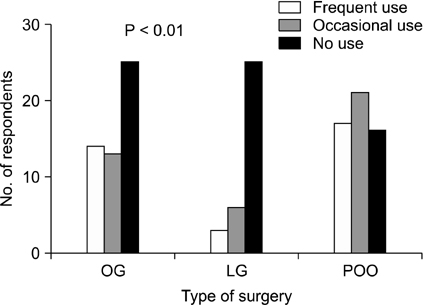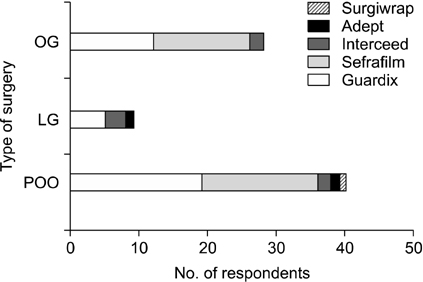J Korean Surg Soc.
2013 Mar;84(3):160-167.
Current status of the use of antiadhesive agents for gastric cancer surgery: a questionnaire survey in South Korea
- Affiliations
-
- 1Department Surgery, Gyeongsang National University School of Medicine, Jinju, Korea. yjleegnu@gmail.com
- 2Gyeongnam Regional Cancer Center, Jinju, Korea.
- 3Institue of Health Sciences, Gyeongsang National University, Jinju, Korea.
Abstract
- PURPOSE
The aim of this study was to investigate the current status of the use of antiadhesive agents (AAdAs) via a questionnaire and to discuss the availability of AAdAs.
METHODS
The survey was sent to a list of members that was approved by the Korean Gastric Association. The survey included questions on AAdA use by surgeons, the type of AAdAs used, and the reasons for not using AAdAs. Surgeons were also asked to describe complications related to AAdAs, and the reliability of its use.
RESULTS
The response rate was 21%. The rates of frequent use stratified by procedure were 26.9% (14/52) for open gastrectomy, 5.9% (3/51) for laparoscopic gastrectomy, and 31.5% (17/54) for surgery for postoperative bowel obstruction (P < 0.01). After including data from the occasional use group, the corresponding values were 51.9% (27/52), 19.6% (10/51), and 70.4% (38/54), respectively (P < 0.01). Sefrafilm and Guardix were most commonly used for open procedures. Guardix and Interceed were most commonly used for laparoscopic surgery. The primary reasons for nonuse of AAdAs were ineffectiveness and high cost. Ten percent (4/40) of surgeons observed complications associated with AAdAs. A minority (17.3%, 9/52) had positive attitudes toward AAdAs. The majority of respondents expressed neutral (73.1%, 38/52) or negative (9.6%, 5/52) attitudes toward AAdAs.
CONCLUSION
The low use rates of AAdAs in gastric cancer surgery may be attributable to perceptions that AAdAs are ineffective, unreliable, and costly. We anticipate the emergence of promising antiadhesive strategies that reach far beyond the limitations of current products.
Keyword
MeSH Terms
Figure
Reference
-
1. Diamond MP, Freeman ML. Clinical implications of postsurgical adhesions. Hum Reprod Update. 2001. 7:567–576.2. Liakakos T, Thomakos N, Fine PM, Dervenis C, Young RL. Peritoneal adhesions: etiology, pathophysiology, and clinical significance. Recent advances in prevention and management. Dig Surg. 2001. 18:260–273.3. Ellis H, Moran BJ, Thompson JN, Parker MC, Wilson MS, Menzies D, et al. Adhesion-related hospital readmissions after abdominal and pelvic surgery: a retrospective cohort study. Lancet. 1999. 353:1476–1480.4. Ray NF, Denton WG, Thamer M, Henderson SC, Perry S. Abdominal adhesiolysis: inpatient care and expenditures in the United States in 1994. J Am Coll Surg. 1998. 186:1–9.5. Wilson MS. Practicalities and costs of adhesions. Colorectal Dis. 2007. 9:Suppl 2. 60–65.6. Johns A. Evidence-based prevention of post-operative adhesions. Hum Reprod Update. 2001. 7:577–579.7. Ward BC, Panitch A. Abdominal adhesions: current and novel therapies. J Surg Res. 2011. 165:91–111.8. Inaba T, Okinaga K, Fukushima R, Iinuma H, Ogihara T, Ogawa F, et al. Prospective randomized study of two laparotomy incisions for gastrectomy: midline incision versus transverse incision. Gastric Cancer. 2004. 7:167–171.9. Korenaga D, Yasuda M, Takesue F, Honda M, Inutsuka S, Nagahama S, et al. Factors influencing the development of small intestinal obstruction following total gastrectomy for gastric cancer: the impact of reconstructive route in the Roux-en-Y procedure. Hepatogastroenterology. 2001. 48:1389–1392.10. Hayashi S, Takayama T, Masuda H, Kochi M, Ishii Y, Matsuda M, et al. Bioresorbable membrane to reduce postoperative small bowel obstruction in patients with gastric cancer: a randomized clinical trial. Ann Surg. 2008. 247:766–770.11. Kawamura H, Yokota R, Yokota K, Watarai H, Tsunoda Y, Yamagami H, et al. A sodium hyaluronate carboxymethylcellulose bioresorbable membrane prevents postoperative small-bowel adhesive obstruction after distal gastrectomy. Surg Today. 2010. 40:223–227.12. Park JS, Cha SJ, Kim BG, Choi YS, Kwon GY, Kang H, et al. An assessment of the effects of a hyaluronan-based solution on reduction of postsurgical adhesion formation in rats: a comparative study of hyaluronan-based solution and two film barriers. J Surg Res. 2011. 168:49–55.13. Ahn HS, Lee HJ, Yoo MW, Jeong SH, Han TS, Kim WH, et al. Efficacy of an injectable thermosensitive gel on postoperative adhesion in rat model. J Korean Surg Soc. 2010. 79:239–245.14. Oh SJ, Choi WB, Song J, Hyung WJ, Choi SH, Noh SH, et al. Complications requiring reoperation after gastrectomy for gastric cancer: 17 years experience in a single institute. J Gastrointest Surg. 2009. 13:239–245.15. Van den Tol PM, van Rossen EE, van Eijck CH, Bonthuis F, Marquet RL, Jeekel H. Reduction of peritoneal trauma by using nonsurgical gauze leads to less implantation metastasis of spilled tumor cells. Ann Surg. 1998. 227:242–248.16. Adams M, Lee TH, Busch MP, Heitman J, Marshall GJ, Gjerset GF, et al. The Transfusion Safety Study Group. Rapid freezing of whole blood or buffy coat samples for polymerase chain reaction and cell culture analysis: application to detection of human immunodeficiency virus in blood donor and recipient repositories. Transfusion. 1993. 33:504–508.17. Schwarz RE, Zagala-Nevarez K. Recurrence patterns after radical gastrectomy for gastric cancer: prognostic factors and implications for postoperative adjuvant therapy. Ann Surg Oncol. 2002. 9:394–400.18. D'Angelica M, Gonen M, Brennan MF, Turnbull AD, Bains M, Karpeh MS. Patterns of initial recurrence in completely resected gastric adenocarcinoma. Ann Surg. 2004. 240:808–816.19. Kling J. Genzyme's Seprafilm gets FDA marketing nod. Nat Biotechnol. 1996. 14:572.20. Diamond MP. Seprafilm Adhesion Study Group. Reduction of adhesions after uterine myomectomy by Seprafilm membrane (HAL-F): a blinded, prospective, randomized, multicenter clinical study. Fertil Steril. 1996. 66:904–910.21. Tsapanos VS, Stathopoulou LP, Papathanassopoulou VS, Tzingounis VA. The role of Seprafilm bioresorbable membrane in the prevention and therapy of endometrial synechiae. J Biomed Mater Res. 2002. 63:10–14.22. Salum M, Wexner SD, Nogueras JJ, Weiss E, Koruda M, Behrens K, et al. Does sodium hyaluronate- and carboxymethylcellulose-based bioresorbable membrane (Seprafilm) decrease operative time for loop ileostomy closure? Tech Coloproctol. 2006. 10:187–190.23. Erturk S, Yuceyar S, Temiz M, Ekci B, Sakoglu N, Balci H, et al. Effects of hyaluronic acid-carboxymethylcellulose antiadhesion barrier on ischemic colonic anastomosis: an experimental study. Dis Colon Rectum. 2003. 46:529–534.24. Nordic Adhesion Prevention Study Group. The efficacy of Interceed(TC7)* for prevention of reformation of postoperative adhesions on ovaries, fallopian tubes, and fimbriae in microsurgical operations for fertility: a multicenter study. Fertil Steril. 1995. 63:709–714.25. Farquhar C, Vandekerckhove P, Watson A, Vail A, Wiseman D. Barrier agents for preventing adhesions after surgery for subfertility. Cochrane Database Syst Rev. 2000. (2):CD000475.26. Verco SJ, Peers EM, Brown CB, Rodgers KE, Roda N, diZerega G. Development of a novel glucose polymer solution (icodextrin) for adhesion prevention: pre-clinical studies. Hum Reprod. 2000. 15:1764–1772.27. Kim JH, Lee JH, Yoon JH, Chang JH, Bae JH, Kim KS. Antiadhesive effect of the mixed solution of sodium hyaluronate and sodium carboxymethylcellulose after endoscopic sinus surgery. Am J Rhinol. 2007. 21:95–99.28. EVPU Slovak testing centre SKTC 101. List of issued certificated [Internet]. c2012. cited 2012 Aug 22. EVPU;Available from: http://www.evpu.sk/sktc/certificates/index.php?language=english.29. Korea Food & Drug Administration [Internet]. c2013. cited 2012 Aug 22. Cheongwon: Korea Food & Drug Administration;Available from: http://www.kfda.go.kr/index.jsp.30. Cox MR, Gunn IF, Eastman MC, Hunt RF, Heinz AW. The operative aetiology and types of adhesions causing small bowel obstruction. Aust N Z J Surg. 1993. 63:848–852.
- Full Text Links
- Actions
-
Cited
- CITED
-
- Close
- Share
- Similar articles
-
- Implementation of Enhanced Recovery after Surgery (ERAS) Program in Perioperative Management of Gastric Cancer Surgery: a Nationwide Survey in Korea
- Nationwide Survey of the Database System on Gastric Cancer Patients
- Current Status of Clinical Practice for Gastric Cancer Patients in Korea: A Nationwide Survey
- Post-operative Therapy for Gastric Adenocarcinoma): Current Status & Future Strategies
- Recent advance in tailored treatment of gastric cancer



